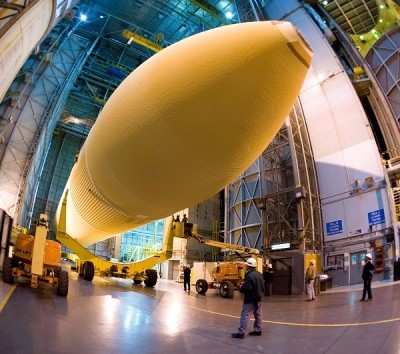Thu, Mar 04, 2010
Tank Will Fly On STS-133 In September
 As the Space Shuttle program winds
down, we're going to see a lot of these kinds of stories over the
next few months. The program's final flight tank - designated
External Tank-138 - has completed a critical production milestone
at the NASA Michoud Assembly Facility. The tanks are built by
Lockheed Martin in New Orleans, where its engineers and technicians
mechanically spliced ET-138's liquid oxygen (LO2)/intertank to the
liquid hydrogen (LH2) tank, thus producing "a whole tank" for the
first time in the production process.
As the Space Shuttle program winds
down, we're going to see a lot of these kinds of stories over the
next few months. The program's final flight tank - designated
External Tank-138 - has completed a critical production milestone
at the NASA Michoud Assembly Facility. The tanks are built by
Lockheed Martin in New Orleans, where its engineers and technicians
mechanically spliced ET-138's liquid oxygen (LO2)/intertank to the
liquid hydrogen (LH2) tank, thus producing "a whole tank" for the
first time in the production process.
The work is performed in Cell A in the 20-story-tall Vertical
Assembly Building, and is the only time during production that the
tank is standing upright. Workers also completed foam closeouts on
the LH2 to intertank flange.
An External Tank is actually three components in one. The
54.6-foot-tall bullet-shaped LO2 tank sits at the top. The
22.5-foot-long intertank separates the LO2 tank and the LH2 tank
and does not hold fuel. Unpressurized, the intertank serves as the
forward attachment point for the Solid Rocket Boosters. The bottom
vessel is the 96.7-foot-tall LH2 tank. The LO2 tank and intertank
are already spliced together when they enter Cell A.

Lockheed Martin employees loaded the tanks into the cell and
completed the splicing and laydown of the tank in a record 40 days.
The prior eight tanks averaged 60 days in Cell A.
ET-138 now proceeds to the Final Assembly area for more
processing and is scheduled for completion June 29. When ET-138 is
delivered to NASA, it will be 15 stories tall (154 feet), nearly 28
feet in diameter, and weigh 58,500 pounds empty. When filled with
534,000 gallons of propellant on the launch pad, the tank will
weigh nearly 1.7 million pounds. ET-138 is scheduled to launch with
Space Shuttle Discovery (STS-133) on September 16 -- the final
shuttle launch of the 29-year program. ET-138 will help propel
Discovery to orbit and then separate from the shuttle 81/2 minutes
post-launch after Main Engine Cut-off or MECO.
More News
Aero Linx: Model Aeronautical Association of Australia MAAA clubs are about fun flying, camaraderie and community. For over 75 years, the MAAA has been Australia’s largest fl>[...]
Touchdown Zone Lighting Two rows of transverse light bars located symmetrically about the runway centerline normally at 100 foot intervals. The basic system extends 3,000 feet alon>[...]
“Discovery and innovation are central to our mission at Virgin Galactic. We’re excited to build on our successful record of facilitating scientific experiments in subor>[...]
How To Get A Story On Aero-TV News/Feature Programming How do I submit a story idea or lead to Aero-TV? If you would like to submit a story idea or lead, please contact Jim Campbel>[...]
Student Pilot Reported That During Rotation, “All Of A Sudden The Back Of The Plane Kicked To The Right..." Analysis: The student pilot reported that during rotation, “>[...]
 ANN's Daily Aero-Linx (05.02.24)
ANN's Daily Aero-Linx (05.02.24) ANN's Daily Aero-Term (05.02.24): Touchdown Zone Lighting
ANN's Daily Aero-Term (05.02.24): Touchdown Zone Lighting Aero-News: Quote of the Day (05.02.24)
Aero-News: Quote of the Day (05.02.24) ANN FAQ: Contributing To Aero-TV
ANN FAQ: Contributing To Aero-TV NTSB Final Report: Cirrus Design Corp SR20
NTSB Final Report: Cirrus Design Corp SR20




